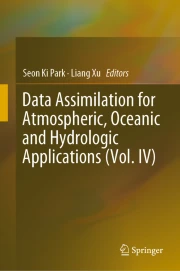Data Assimilation for Atmospheric, Oceanic and Hydrologic Applications (Vol. IV)

This is a preview of subscription content, log in via an institution to check access.
Access this book
Subscribe and save
Springer+ Basic
€32.70 /Month
- Get 10 units per month
- Download Article/Chapter or eBook
- 1 Unit = 1 Article or 1 Chapter
- Cancel anytime
Buy Now
eBook EUR 139.09
Price includes VAT (France)
Softcover Book EUR 179.34
Price includes VAT (France)
Hardcover Book EUR 179.34
Price includes VAT (France)
Tax calculation will be finalised at checkout
Other ways to access
About this book
This book contains the most recent progress in data assimilation in meteorology, oceanography and hydrology including land surface. It spans both theoretical and applicative aspects with various methodologies such as variational, Kalman filter, ensemble, Monte Carlo and artificial intelligence methods. Besides data assimilation, other important topics are also covered including adaptive observations, sensitivity analysis, parameter estimation and AI applications. The book is useful to individual researchers as well as graduate students for a reference in the field of data assimilation.
Similar content being viewed by others

Acoustic Data Assimilation: Concepts and Examples
Chapter © 2016

Ocean Wave Modeling from Satellite Images Using Data Assimilation
Chapter © 2022
Comparison of Data Assimilation Methods in Hydrodynamics Ocean Circulation Models
Article 19 July 2019
Keywords
- Hybrid Data Assimilation
- Kalman Filter
- Monte Carlo Method
- Artificial Intelligence Application
- Wiener Polynomial Chaos Expansion
Table of contents (26 chapters)
Front Matter
Pages i-xxi
Data Assimilation for Chaotic Dynamics
- Alberto Carrassi, Marc Bocquet, Jonathan Demaeyer, Colin Grudzien, Patrick Raanes, Stéphane Vannitsem
Multifidelity Data Assimilation for Physical Systems
- Andrey A. Popov, Adrian Sandu
Pages 43-67
Filtering with One-Step-Ahead Smoothing for Efficient Data Assimilation
- Boujemaa Ait-El-Fquih, Ibrahim Hoteit
Pages 69-96
Sparsity-Based Kalman Filters for Data Assimilation
Pages 97-114
Perturbations by the Ensemble Transform
- Kazuo Saito, Le Duc, Takumi Matsunobu, Takuya Kurihana
Pages 115-141
Stochastic Representations for Model Uncertainty in the Ensemble Data Assimilation System
- Sujeong Lim, Seon Ki Park
Pages 143-153
Second-Order Methods in Variational Data Assimilation
- François-Xavier Le Dimet, Victor Shutyaev
Pages 155-183
Statistical Parameter Estimation for Observation Error Modelling: Application to Meteor Radars
- Elizabeth A. Satterfield, Joanne A. Waller, David D. Kuhl, Dan Hodyss, Karl W. Hoppel, Stephen D. Eckermann et al.
Pages 185-213
Observability Gramian and Its Role in the Placement of Observations in Dynamic Data Assimilation
- S. Lakshmivarahan, John M. Lewis, Sai Kiran Reddy Maryada
Pages 215-257
Placement of Observations for Variational Data Assimilation: Application to Burgers’ Equation and Seiche Phenomenon
- John M. Lewis, S. Lakshmivarahan, S. K. R. Maryada
Pages 259-275
Analysis, Lateral Boundary, and Observation Impacts in a Limited Area Model
Pages 277-291
Assimilation of In-Situ Observations
- Patricia M. Pauley, Bruce Ingleby
Pages 293-371
GNSS-RO Sounding in the Troposphere and Stratosphere
- Benjamin Ruston, Neill Bowler, Sean Healy, Hui Shao
Pages 373-395
Impact of Assimilating the Special Radiosonde Observations on COAMPS Arctic Forecasts During the Year of Polar Prediction
- Xiaodong Hong, James D. Doyle, Daniel P. Tyndall
Pages 397-410
Images Assimilation: An Ocean Perspective
- François-Xavier Le Dimet, Hans E. Ngodock, Innocent Souopgui
Pages 411-425
Sensitivity Analysis in Ocean Acoustic Propagation
- Hans E. Ngodock, Matthew J. Carrier, Josette Fabre, Robert Zingarelli, Scott Smith, Innocent Souopgui
Pages 427-438
Difficulty with Sea Surface Height Assimilation When Relying on an Unrepresentative Climatology
- John J. Osborne, Matthew J. Carrier, Hans E. Ngodock
Pages 439-464
Theoretical and Practical Aspects of Strongly Coupled Aerosol-Atmosphere Data Assimilation
- Ting-Chi Wu, Milija Zupanski, Anton Kliewer, Lewis Grasso, Leah D. Grant
Pages 465-505
Improving Near-Surface Weather Forecasts with Strongly Coupled Land–Atmosphere Data Assimilation
Pages 507-523
Editors and Affiliations
Climate and Energy Systems Engineering, Ewha Womans University, Seoul, Korea (Republic of)
Marine Meteorology Division, Naval Research Laboratory, Monterey, USA
About the editors
Seon Ki Park is Professor of Environmental Science and Engineering and Founding Director of the Severe Storm Research Center and the Center for Climate/Environment Change Prediction Research at the Ewha Womans University in Seoul, Korea. He obtained a Ph.D. in Meteorology from the University of Oklahoma and M.S. and B.S. in Meteorology from the Seoul National University, Korea. He had worked as a research scientist at the University of Oklahoma, University of Maryland and NASA/Goddard Space Flight Center. His research focuses on storm- and meso-scale meteorology, hydrometeorology, and parameter estimation and data assimilation to improve numerical weather/climate prediction.
Liang Xu is the Head of Atmospheric Dynamics & Prediction Branch and a Meteorologist at the Marine Meteorology Division, Naval Research Laboratory in Monterey, California, USA. He leads a fully integrated research program encompassing all aspects of numerical weather prediction and data assimilation, focusing on critical issues related to the analysis and prediction of atmospheric processes and phenomena within the Navy's Earth System Prediction Capability. He and his team have developed, tested, and transitioned to the Fleet Numerical Meteorology and Oceanographic Center (FNMOC), an operational global atmospheric 4DVar data assimilation system.
Bibliographic Information
- Book Title : Data Assimilation for Atmospheric, Oceanic and Hydrologic Applications (Vol. IV)
- Editors : Seon Ki Park, Liang Xu
- DOI : https://doi.org/10.1007/978-3-030-77722-7
- Publisher : Springer Cham
- eBook Packages : Earth and Environmental Science , Earth and Environmental Science (R0)
- Copyright Information : The Editor(s) (if applicable) and The Author(s), under exclusive license to Springer Nature Switzerland AG 2022
- Hardcover ISBN : 978-3-030-77721-0 Published: 10 November 2021
- Softcover ISBN : 978-3-030-77724-1 Published: 11 November 2022
- eBook ISBN : 978-3-030-77722-7 Published: 09 November 2021
- Edition Number : 1
- Number of Pages : XXI, 705
- Number of Illustrations : 15 b/w illustrations, 224 illustrations in colour
- Topics : Monitoring/Environmental Analysis , Optimization , Computer Applications , Oceanography

